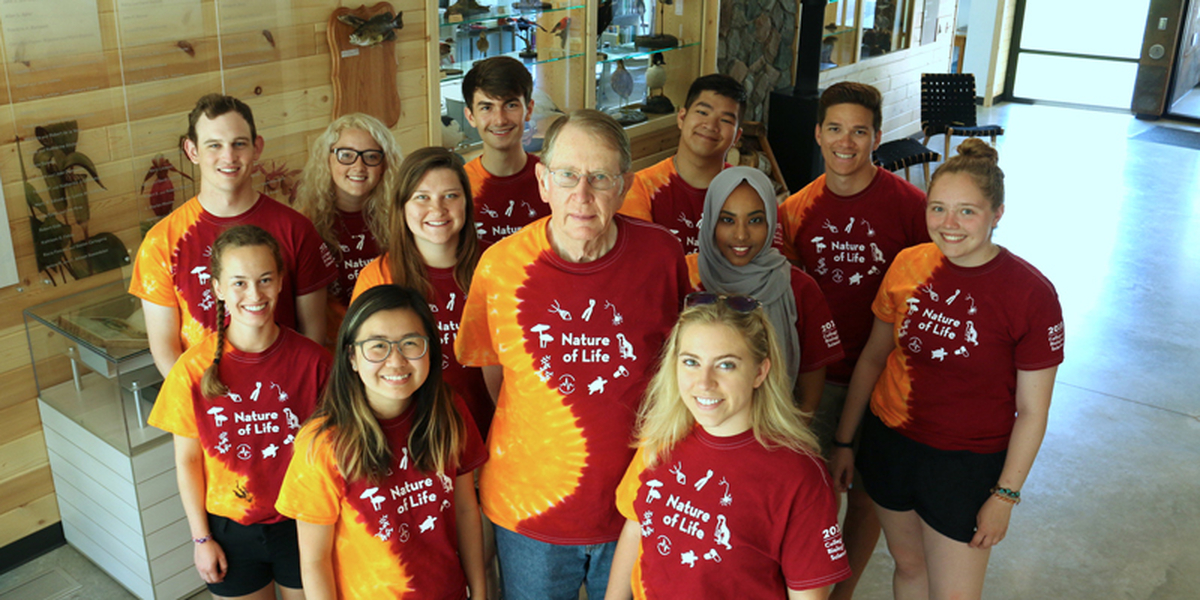
Professor Emeritus John Anderson has made the four-hour drive to Itasca State Park every summer for 16 years to participate in Nature of Life, the Collegeís signature program at Itasca Biological Station and Laboratories. Over the course of three weeks, hundreds of soon-to-be freshmen make their way through four days of biology modules and cohort-building activities. Anderson gives his take on teaching the freshly minted freshmen a lesson in University and College traditions.
You were among the faculty who developed Nature of Life, and you have been part of the program from the start. Why do you think Nature of Life leaves such a lasting impression on students and alumni?
The transition from the high school environment to the university environment is challenging in many ways: making oneís way among a massive crowd of people totally unknown to one another, the stress of more demanding course standards, living away from home and family. NOL addresses these challenges head on by building a sense of community among CBS students. When they arrive on campus for their first semester, they have already become acquainted with a substantial number of their classmates. They have already been briefly submerged in the details of two modules and learned interesting aspects of the University of Minnesota. Having had the four-day NOL experience, they are better prepared to begin their four-year on-campus journey. Many have made lifelong friendships.
You and a team of student photographers take hundreds of photos each session, some of which you use in a slideshow at each NOL ìgraduation ceremonyî on the studentsí final night at Itasca. What prompted you to begin this tradition?
As with most enterprises, the Nature of Life slideshow has many contributing roots. In the initial years of NOL my module involved the extraction of the pigments of plant leaves followed by their separation by paper chromatography. The very visual result was a chromatogram which had varied proportions of the green bands of chlorophylls a and b as well as the yellow bands of carotenes and xanthophylls. A digital photograph of the studentís chromatogram was supplied to each participant as a record of their accomplishment.
When I discontinued leading my module on plant pigments, I continued Nature of Life participation through traditions, which allowed time to devote to the slideshow, an idea introduced by an NOL coordinator. Associate peer mentors were provided cameras and asked to take photos, since much NOL activity takes place simultaneously at various locations.
The slideshow illustrates the essence of the Itasca experience by including photos of each module and activity. An important objective is to include photos of every student, peer mentor and faculty participant. With the help of the associate peer mentors, about a thousand photos are collected for each Nature of Life session. About a third of these are selected for the slideshow. The presentation is enhanced by the inclusion of Interesting, upbeat instrumental music.
You teach the students about University and College traditions over the course of each session. They learn everything from how to navigate the Gopher Way to how to sing the Rouser, hand movements and all. What is your favorite tradition and why?
It is difficult to single out a favorite tradition, since it takes the collection of many traditions to flesh out the feeling of belonging to the University of Minnesota community. It is especially fun to tell the NOL participants about how we became known as the Golden Gophers. Nevertheless, the students seem to respond most positively to the Rouser. Admittedly the peer mentors and I specifically stimulate the enthusiasm of the incoming students. It is noteworthy that from time to time random groups of CBS students can be heard singing the Rouser. The leadership and enthusiasm of CBS students in singing the Rouser at Convocation is also especially gratifying!